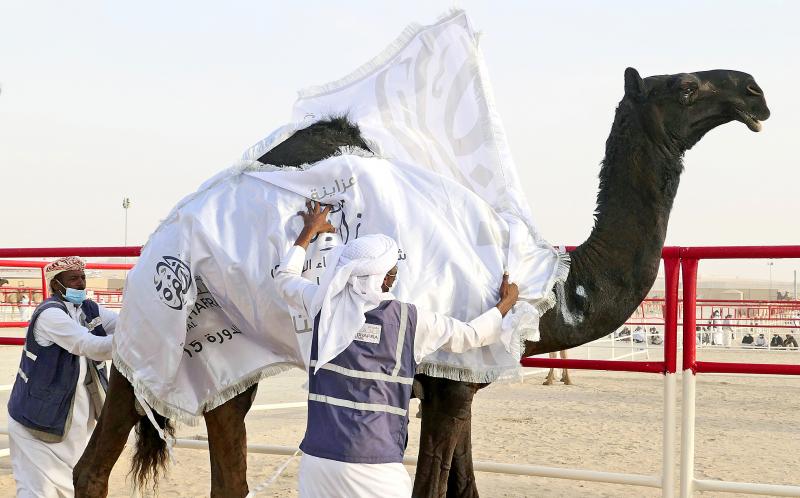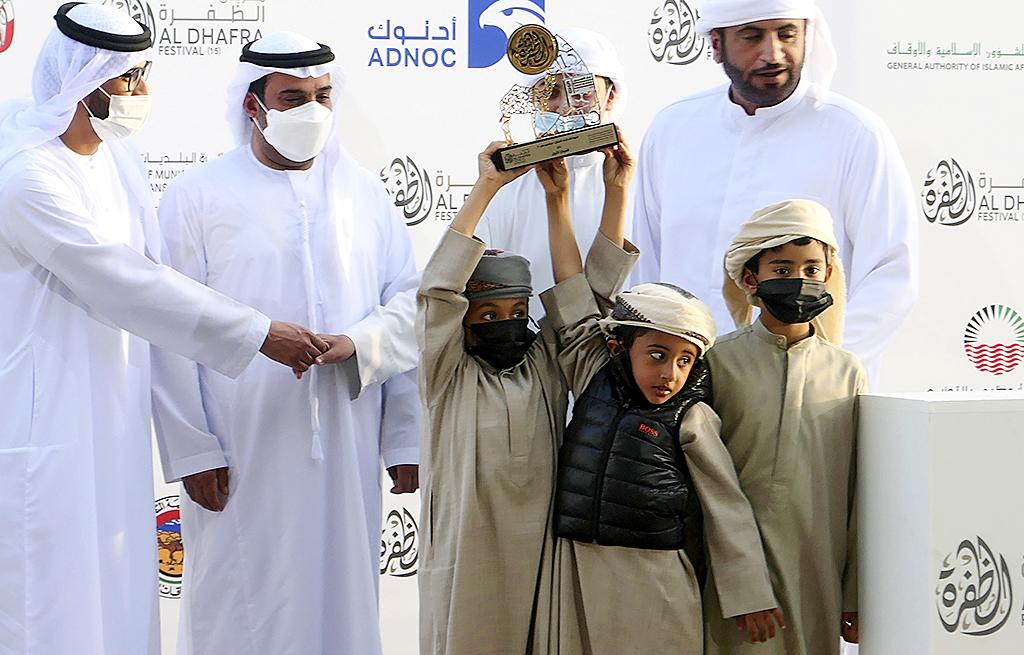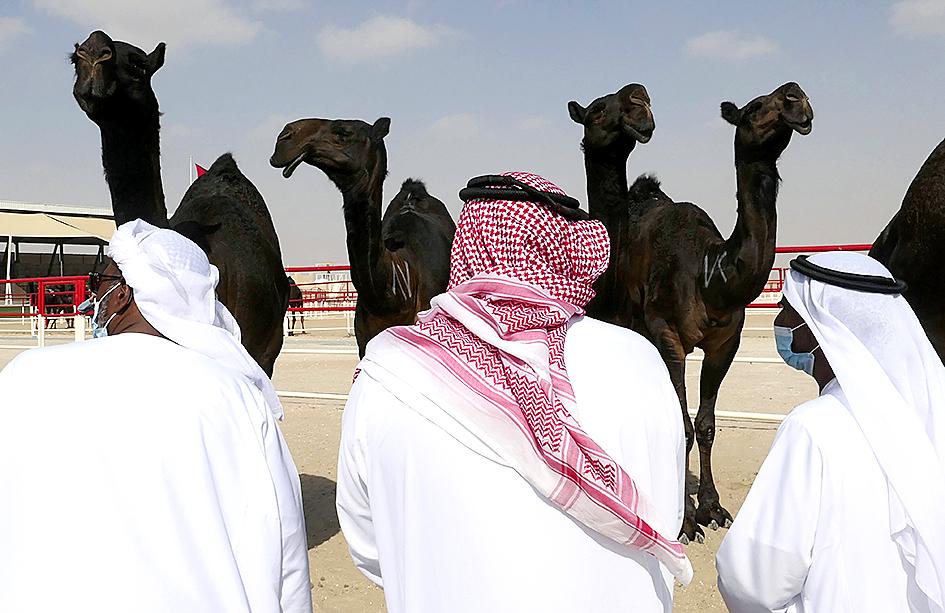Deep in the desert of the United Arab Emirates, the moment that camel breeders had been waiting for arrived.
Families hauled their camels through wind-carved sands. Servers poured tiny cups of Arabic coffee. Judges descended on desert lots.
A single question loomed over the grandstand: Which camels were most beautiful?

Photo: AP
Even as the Omicron variant rips through the world, legions of breeders from Bahrain, Kuwait, Oman, Saudi Arabia and Qatar traveled to the UAE’s southwestern desert this week with 40,000 of their most beautiful camels for the Al Dhafra Festival.
The five-man jury at the annual pageant insists beauty is not in the eye of the beholder. Camel aesthetics are evaluated according to precise categories determined generations ago. Only female camels participate because males fight too much, authorities said. As hundreds of woolly black camels trotted through the dusty pastures, necks and humps bobbing, one of the organizers, Mohammed al-Muhari, outlined the platonic ideal.
Necks must be long and slim, cheeks broad and hooves large, he said on Wednesday. Lips must droop. They must walk tall with graceful posture.

Photo: AP
“It’s not so different from humans,” al-Muhari said, his robe sparkling white amid clouds of dust.
The high standards have prompted many breeders to seek an advantage, using banned Botox injections to inflate the camel’s lips, muscle relaxants to soften the face and silicone wax injections to expand the hump.
Festival spokesman Abdel Hadi Saleh declined to say how many participants had been disqualified over plastic surgery this week. All camels undergo rigorous medical exams to detect artificial touch-ups and hormones before entering Al Dhafra Festival.

Photo: AP
Since Emirati investigators began employing X-rays and sonar systems a few years ago, Saleh said the number of cheaters has plummeted.
“We easily catch them, and they realize getting caught, it’s not worth the cost to their reputation,” he said.
REVIVING HERITAGE
A great deal is at stake. Al Dhafra Festival offers the top 10 winners in each category prizes ranging from US$1,300 to US$13,600. At the main Saudi contest, the most beautiful fetch US$66 million. Camels change hands in deals worth millions of dirhams.
But breeders insist it’s not only about the money.
“It is a kind of our heritage and custom that the (Emirati rulers) revived,” said 27-year-old camel owner Saleh al-Minhali from Abu Dhabi. He sported designer sunglasses over his traditional headdress and Balenciaga sneakers under his kandura, or Emirati tunic.
Gone are the days when camels were integral to daily life in the federation of seven sheikhdoms, a chapter lost as oil wealth and global business transformed Dubai and Abu Dhabi into skyscraper-studded hubs with marbled malls, luxury hotels and throbbing nightclubs. Foreigners outnumber locals nearly nine to one in the country.
However, experts say Emiratis are increasingly searching for meaning in echoes of the past — Bedouin traditions that prevailed before the UAE became a nation 50 years ago.
“Younger Emiratis who have identity issues are going back to their heritage to find a sense of belonging,” said Rima Sabban, a sociologist at Zayed University in Dubai. “The society developed and modernized so fast it creates a crisis inside.”
Camels race at old-world racetracks in the Emirates, and still offer milk, meat and a historic touchstone to citizens. Festivals across the country celebrate the camel’s significance. Al Dhafra also features falcon racing, dromedary dancing and a camel milking contest.
“People in Dubai may not even think about them, but young people here care deeply about camels,” said Mahmoud Suboh, a festival coordinator from Liwa Oasis at the northern edge of the desert’s Empty Quarter. Since 2008, he has watched the fairgrounds transform from a remote desert outpost into an extravaganza that draws camel lovers from around the world.
CAMEL INFLUENCERS
In a sign of the contest’s exploding popularity, about a dozen young Emirati men who call themselves “camel influencers” filmed and posed with the camels on Wednesday, broadcasting live to thousands of Instagram followers.
The digital likes have proven important this year, as the COVID-19 pandemic curtailed tourism to the festival and dampened the mood. Police checked that visitors had received both vaccine doses and tested negative for the virus. Authorities nagged attendees to adjust their face masks, threatening fines. There were few foreigners or other spectators strolling the site Wednesday.
Each category in the 10-day pageant is divided into two types of camels: Mahaliyat, the tan breed that originates from the UAE and Oman, and Majaheen, the darker breed from Saudi Arabia. Wednesday’s showcase focused on five-year-old black Majaheen camels.
For hours, judges scrutinized each camel, scribbling lists of the animal’s body parts for scoring purposes. Breeders shouted to startle camels so they’d look up and show off elongated necks. As the sun set over the sands, the winning breeders were called to accept their gleaming trophies. Down below in the dirt rings, camels were crowned with gold and silver-lined shawls.
“Until now we are the first in the category ... We’ve received over 40 prizes (in various camel contests) this year alone,” beamed Mohammed Saleh bin Migrin al-Amri as he juggled four trophies from the day, including two golds.
Then he jumped into his Toyota Land Cruiser. The victory parade of honking SUVs and grunting camels faded behind the desert dunes.

On April 26, The Lancet published a letter from two doctors at Taichung-based China Medical University Hospital (CMUH) warning that “Taiwan’s Health Care System is on the Brink of Collapse.” The authors said that “Years of policy inaction and mismanagement of resources have led to the National Health Insurance system operating under unsustainable conditions.” The pushback was immediate. Errors in the paper were quickly identified and publicized, to discredit the authors (the hospital apologized). CNA reported that CMUH said the letter described Taiwan in 2021 as having 62 nurses per 10,000 people, when the correct number was 78 nurses per 10,000

May 5 to May 11 What started out as friction between Taiwanese students at Taichung First High School and a Japanese head cook escalated dramatically over the first two weeks of May 1927. It began on April 30 when the cook’s wife knew that lotus starch used in that night’s dinner had rat feces in it, but failed to inform staff until the meal was already prepared. The students believed that her silence was intentional, and filed a complaint. The school’s Japanese administrators sided with the cook’s family, dismissing the students as troublemakers and clamping down on their freedoms — with

As Donald Trump’s executive order in March led to the shuttering of Voice of America (VOA) — the global broadcaster whose roots date back to the fight against Nazi propaganda — he quickly attracted support from figures not used to aligning themselves with any US administration. Trump had ordered the US Agency for Global Media, the federal agency that funds VOA and other groups promoting independent journalism overseas, to be “eliminated to the maximum extent consistent with applicable law.” The decision suddenly halted programming in 49 languages to more than 425 million people. In Moscow, Margarita Simonyan, the hardline editor-in-chief of the

Six weeks before I embarked on a research mission in Kyoto, I was sitting alone at a bar counter in Melbourne. Next to me, a woman was bragging loudly to a friend: She, too, was heading to Kyoto, I quickly discerned. Except her trip was in four months. And she’d just pulled an all-nighter booking restaurant reservations. As I snooped on the conversation, I broke out in a sweat, panicking because I’d yet to secure a single table. Then I remembered: Eating well in Japan is absolutely not something to lose sleep over. It’s true that the best-known institutions book up faster